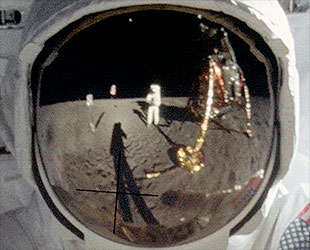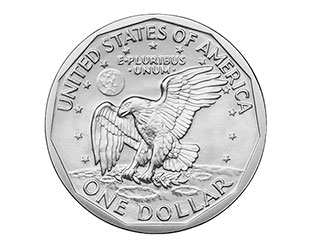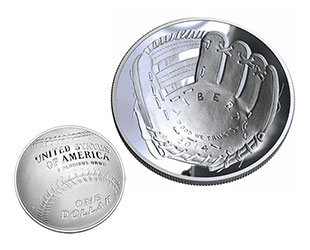 advertisements advertisements
|

|
Lawmakers call for golden curved coins to mark Apollo 11 golden anniversary

The iconic image of moonwalker Buzz Aldrin's helmet visor will serve as the design for the back of a new U.S. coin celebrating the 50th anniversary of Apollo 11, if Congress approves. (NASA) |
June 16, 2015 — The United States Mint may strike gold curved coins to commemorate the golden anniversary of the first moon landing, if a new bill is signed into law.
A bipartisan group of five members of Congress on June 10 introduced legislation that would direct the Secretary of the Treasury to mint the coins to mark five decades since Neil Armstrong, Buzz Aldrin and Michael Collins launched to the moon in July 1969. The "Apollo 11 50th Anniversary Commemorative Coin Act" (HR 2726) calls for gold, silver and half-dollar clad coins to be struck in 2019.
"The United States remains the only country to have ever landed humans on a celestial body off the Earth," stated Representative Bill Posey (FL-08), who co-sponsored the bill and was a member of the Apollo launch team in 1969. "Honoring that great feat and recognizing [the] astronauts ... is what our bipartisan legislation is all about."
Joining Posey backing the bill were Frederica Wilson (D-FL), John Culberson (R-TX), Gene Green (D-TX) and Rod Blum (R-IA).
"I'm proud to cosponsor this bill with my colleagues, which celebrates one of the greatest achievements in history, not only for America, but for mankind," Green commented. "The commemorative coin will serve a reminder of what we have achieved and an inspiration to continue to strive for greatness."

The Apollo 11 patch was struck on the reverse of the Eisenhower and Susan B. Anthony dollars. (United States Mint) |
The act calls for the coins to be issued in four legal tender denominations:
$5 gold coins - not more than 50,000 pieces, with a diameter of 0.85 inches (2.16 cm); $1 silver coins - not more than 400,000 pieces, with a diameter of 1.5 in. (3.8 cm); Half-dollar clad coins - not more than 750,000, with a diameter of 1.25 in. (3.2 cm); Proof-silver $1 coins - not more than 100,000, with a diameter of 3 inches (7.6 cm).
Each of the coins, regardless of metal, would feature a front (or obverse) design selected by a juried competition overseen by the Secretary of the Treasury after consulting with the Commission of Fine Arts and being reviewed by the Citizen's Coinage Advisory Committee (CCAC), which in 2014 recommended the Apollo 11 theme.
"Such a series of coins wouldn't only be historic but would enjoy commercial success as well," said Michael Olson, the CCAC member who proposed the moon landing coin, in a column for Coin World magazine last month. "It would also serve to bring much deserved recognition to NASA's past accomplishments and inspire a new generation."
Per the bill, the back of each coin would feature one of the most iconic images from the Apollo 11 mission.
"The design on the common reverse of the coins minted under this Act shall be a representation of a close-up of the famous 'Buzz Aldrin on the moon' photo taken July 20, 1969, showing just the visor and [a] part of the helmet of astronaut [Aldrin], in which the visor reflects the image of the United States flag and the lunar lander," the legislation reads.
That design would be further highlighted by the shape of the commemoratives.
"The coins minted under this Act shall be produced in a fashion...so that the reverse of the coin is convex to more closely resemble the faceplate of the astronaut's helmet of the time," the bill directs.

As proposed, the Apollo 11 coins would be curved like the 2014 National Baseball Hall of Fame commemoratives. (U.S. Mint) |
The Mint issued its first curved coin to commemorate the 75th anniversary of the National Baseball Hall of Fame in 2014.
Proceeds from the Mint's sale of the Apollo 11 coins would benefit the Astronaut Memorial Foundation and Astronaut Scholarship Foundation's science, technology, engineering and math (STEM) programs, as well as the Smithsonian's "Destination Moon" exhibit at the National Air and Space Museum. The coins would be produced at no cost to U.S. taxpayers.
"We need to inspire the next generation of scientists, engineers and explorers to push the limits and take up the mantle of space exploration to Mars and beyond. So it is fitting that proceeds will fund STEM education," Culberson said.
The U.S. Mint earlier honored the Apollo 11 moon landing by using the mission's official patch as the reverse design on the Eisenhower and Susan B. Anthony dollars issued from 1971 to 1981. The Mint also struck the New Frontier Congressional Gold Medal awarded to Armstrong, Aldrin and Collins (and Mercury astronaut John Glenn) in 2011. |

© 1999-2025 collectSPACE. All rights reserved.

|
|

|

|
